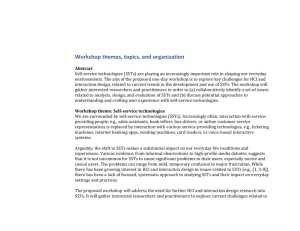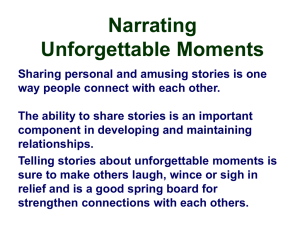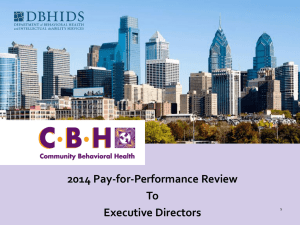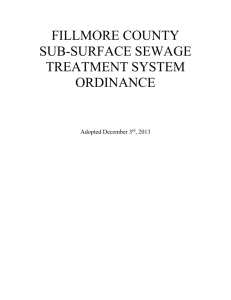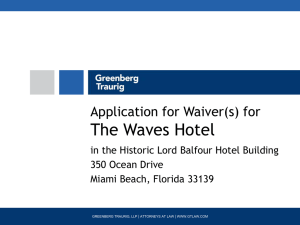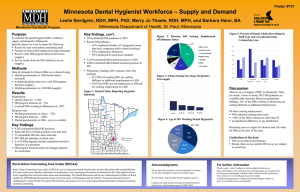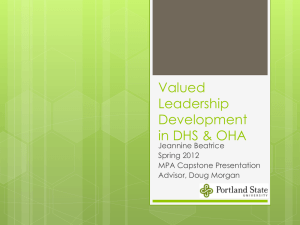Part 3 - Social Services Fiscal Elements
advertisement
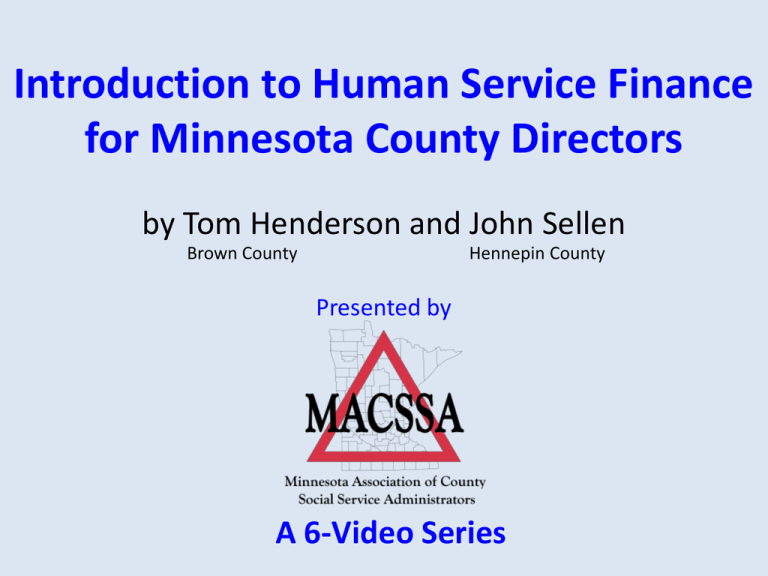
Introduction to Human Service Finance for Minnesota County Directors by Tom Henderson and John Sellen Brown County Hennepin County Presented by A 6-Video Series Introduction to Human Service Finance for Minnesota County Directors 1. 2. 3. 4. 5. 6. Welcome, Overview, & Basic Concepts Cash Assistance & Health Care Social Services Fiscal Elements Children’s Social Services Adult Social Services Budgeting & Conclusion A 6-Video Series 2 Introduction to Human Service Finance for Minnesota County Directors 3. Social Services Fiscal Elements A 6-Video Series 3 7 Shared Topics – Children’s and Adults This video covers seven topics or fiscal elements that apply to both Children’s and Adult Social Services: • Contracts • BRASS • Time Reporting • Social Service Time Study (SSTS) Random Moments • Targeted Case Management (TCM) • Waiver Case Management • Tracking Social Worker Fiscal Performance 4 Contracts: Make or Buy • In social services, your staff do much of the work directly. • When should you buy the service for the client rather than staff providing it themselves? • This is a basic “make or buy” decision that every county wrestles with. • You or someone you trust needs to define and oversee the work either way. 5 Contracts: Make or Buy • Which kinds of work do you trust only to your staff? o Assessments? o Authorizations? o Legal findings? o What? • • • • When might a provider be more effective? What providers are actually available locally? What funding can only the county access? What funding might a provider be more effective at billing and collecting? 6 Contracts: Paying for What? • When you are paying a contracted provider, what are you paying for? • Paying because your board wants them funded? • Paying for a “fire department” that might do little or nothing some of the time but can swing into operation at a moment’s notice? • Paying for units of service that meet your specs? • Paying for specific outcomes? • Paying for performance that meets your standards? • Each is legitimate in its own context. 7 Contracts: Process • • • • • • • Tracking/Monitoring Negotiating Use DHS Model Contracts for MA Waiver Services Financial Statements from Vendors MCIT boilerplate and training available Insurance requirements Changes coming – state may take over many contracts • Blue Earth checklist as a resource 8 BRASS • BRASS (Budgeting, Reporting and Accounting for Social Services) • BRASS categorizes all social services into major program areas and down to specific services. • Social services lend themselves being broken down into categories by service • They work well with BRASS and vice versa – good for budgeting, accounting, and reporting. • Common vocabulary for talking with DHS. 9 BRASS • When a county purchases a service from a provider, then the contract generally specifies which BRASS service or services are being purchased. • If more than one service, then the vendor usually has to break down their invoices by how many units for each kind of BRASS service. • When county staff are providing social services directly to clients, then these get divided up into BRASS services when staff do time reporting. 10 Time Reporting • Time reporting is something that social service staff do, usually in SSIS. • For most social workers, it’s not their favorite thing, although most do it conscientiously. • Time reporting is how SSIS knows that this social worker performed this BRASS service with this particular client at this time on this date. 11 Time Reporting • Time reporting is a big part of how counties get paid for social services. • Time reporting is used to generate reports through which counties earn their capped grant allocations. • Time reporting is used to document trigger events so that Targeted Case Management is billed (to DHS or Managed Care Organizations). • Time reporting is used to document other services so that they can be billed. 12 SSTS Random Moments • Social Service Time Study, or SSTS Random Moments, is another of the four big time studies that DHS conducts. • SSTS Random Moments are designed to perform three important functions: 1. Bring uncapped Federal Revenue to counties for activities that social service staff perform. 2. Bring uncapped MnCHOICES State Revenue as well. 3. Set rates for targeted case management services that many of the same social service staff provide. 13 SSTS Random Moments • Very similar to the IM-RMS we discussed under Cash Assistance and Health Care. • Several times each quarter, every front line social service staffer gets a Random Moment via e-mail. • It asks what the staffer is doing right then. • The staffer chooses from a menu of choices. • It’s completely inaccurate for that staffer, but with a lot of random moments, it builds up a statistically valid picture. 14 SSTS Random Moments • The uncapped Federal Revenue from SSTS includes: o Title IV-E administrative revenue o MA administrative revenue o Rule 25 Chemical Dependency Assessments o MnCHOICES assessment and administrative (including an uncapped state share) 15 SSTS Random Moments • The SSTS is also used as a basis for calculating rates for uncapped Federal Targeted Case Management (TCM) in its four main flavors: o Child Welfare (CW-TCM) o Children’s Mental Health (CMH-TCM) o Adult Mental Health (AMH-TCM) o Vulnerable Adult & Developmental Disabilities (VADD-TCM) • We’ll get back to TCM shortly. 16 SSTS Random Moments • The SSTS is a big deal with lots of money attached. • Staff don’t need to cheat or play games, but they do need to code the Moments accurately. • Random Moments tend to irritate social workers who are busy trying to “get their work done”. • They need to be helped to understand (or sometimes simply instructed) that Moments are important to attend to, that they are in fact part of the work that needs to get done. 17 • Find and review the most recent DHS bulletin on the SSTS. • Staff need to understand when to use which code. • It’s not just fiscal, it’s not just social service staff, it requires work from both. • It crosses lines, so usually the Director needs to lead this or designate someone else with authority and tact to do so. 18 SSTS Random Moments • One problem is that in recent years DHS changed the way they do the SSTS. • One result of this change is that the amount of feedback that counties get from the SSTS is drastically smaller. • This needs to be corrected by DHS. • At times, DHS has said they will provide more feedback. • Otherwise counties are driving very fast down a highway with most of the windshield covered with mud. 19 SSTS Random Moments 20 Targeted Case Management (TCM) • Targeted Case Management (TCM) is part of Medicaid (aka Medical Assistance or MA). • It’s an uncapped federal revenue. • In Minnesota, it’s primarily used for case management to specific populations and comes in four main flavors: 1. 2. 3. 4. Child Welfare (CW-TCM) Children’s Mental Health (CMH-TCM) Adult Mental Health (AMH-TCM) Vulnerable Adult or Developmental Disabilities (VADD-TCM) 21 Targeted Case Management (TCM) • The rates are set through the SSTS Random Moments and some statistics. • The rates are monthly • But you have to bill to actually get the money. • Need to bill that a specific worker provided TCM to a specific client. 22 Targeted Case Management (TCM) • Bill based on a trigger event, usually a face-toface contact by that worker with that client. • The trigger event indicates an entire month’s work of case management was provided. • The Random Moments ensure that a county doesn’t just do trigger events and ignore the rest of the work – or your rate plummets. 23 Brown County TCM Report Let’s zoom in here… 24 Brown County TCM Report 25 Tracking CW-TCM Claims on SSIS 26 MA Waiver Case Management • MA Waiver Case Management is much like Targeted Case Management. • Some staff do both TCM and MA Waiver Case Management, depending on what that client is eligible for this month. • For instance, is a Waiver slot available? – If yes, Waiver Case Management – If no, VADD-TCM • But instead of a trigger event for an entire month’s worth of case management like TCM, the billing for Waiver CM is in 15-minute units. • It’s good to track them at the same time. 27 Tracking Social Worker Fiscal Performance • Social service staff have many responsibilities. • One is to earn some of the funding that pays for them and the services they provide to clients. • It’s possible to become pre-occupied with social worker fiscal performance, but we think that to ignore it is a mistake. 28 Tracking Social Worker Fiscal Performance • Workers with different assignments have access to different uncapped federal and state revenue. • Remember that as you compare them against each other. • Better to consider what that worker can realistically earn. 29 Looking at MA Waiver Case Management 30 Looking at TCM and MA Waiver CM 31 32 Introduction to Human Service Finance for Minnesota County Directors 1. 2. 3. 4. 5. 6. Welcome, Overview, & Basic Concepts Cash Assistance & Health Care Social Services Fiscal Elements Children’s Social Services Adult Social Services Budgeting & Conclusion End of Video 3 33
